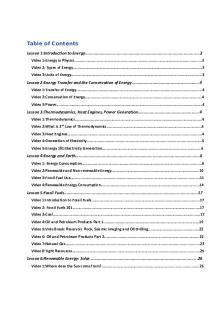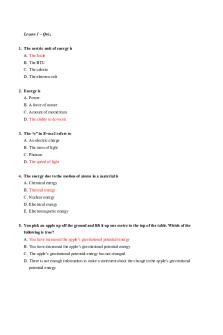Phys 91173 electrcity notes PDF

| Title | Phys 91173 electrcity notes |
|---|---|
| Course | Physics |
| Institution | Secondary School (New Zealand) |
| Pages | 8 |
| File Size | 513.3 KB |
| File Type | |
| Total Downloads | 80 |
| Total Views | 174 |
Summary
notes on the whole topic of electricity. Study material...
Description
No Brain Too Small PHYSICS
AS91173 Demonstrate understanding of electricity and electromagnetism Level 2 Credits 6 Assessment is limited to a selection from the following: Static Electricity: • uniform electric field • electric field strength • force on a charge in an electric field • electric potential energy • work done on a charge moving in an electric field. DC Electricity: • parallel circuits with resistive component(s) in series with the source • circuit diagrams • voltage • current • resistance • energy • power. (Note that removed from old standard are: voltage or current characteristics of diodes.) Electromagnetism: • force on a current carrying conductor in a magnetic field • force on charged particles moving in a magnetic field • induced voltage generated across a straight conductor moving in a uniform magnetic field. (Note that removed from old standard are: a simple generator.) Replacement Information This achievement standard replaced AS90257.
RELATIONSHIPS:
V E= d
F = Eq
Ek = 12 mv 2
Δ E p = Eqd
F = BIL F = Bqv V = BvL q I= t
V=
ΔE q
RT = R1 + R 2 + ...
V = IR
P = IV
1 1 1 = + + ... RT R1 R 2
This achievement standard replaced AS90257.
ΔE P= t
No Brain Too Small PHYSICS
Static Electricity If you rub a plastic ruler on a cat, you will build up a charge. When you touch something earthed, the charge flows from your body and you feel the shock. Vehicles can build up a charge as they move along the road. Because tyres are made of rubber they are insulators and so the charge stays on the vehicle. Some cars give you a shock when you get out of them as the charge goes through you to the ground. Refueling a jumbo jet requires the fuel line to be earthed to make sure that any electric charge created by the rubbing of the fuel on the fuel line cannot form a spark. Clouds can build up charges. Sometimes there is enough energy to form long sparks called lightning. When you use a cloth to rub an insulator such as a balloon or a plastic ruler, electrons are rubbed from one to the other object to the other. Electrons carry negative charges. A negatively charged object has had electrons rubbed on to it. A positively charged object has had electrons rubbed off it. Each electron carries 1.6 x 10-19 Coulombs of charge.
If charged particles are in an electric field – negative charges – such as electrons and beta particles - move towards positive plate. Positive particles - including alpha particles – move toward the negative plate. As the charges move, electrical potential energy is converted to kinetic energy (E = ½ mv2). This is used in processes such as the painting of car bodies.
Δ E p = Eqd
Ek = 12 mv 2
No Brain Too Small PHYSICS
This behaviour can be predicted by electric field lines. Electric fields have both magnitude and direction. The arrows indicate the direction of the force that a positive charge would experience. The field strength, E, of the field can be calculated by
E=
V d
The unit for Electric field strength is V/m or Vm-1 The electric field strength can be used to calculate the value of the force experienced by the charge in an electric field by using the equation
F = Eq If charged particles are moving through an electric field – negative charges move towards positive plate in an arc. Positive particles move toward negative plate in an arc.
Electrical potential is often referred to as voltage where 1 volt = 1 joule /1 coulomb An electric current is a movement of charge. In conductors, the electrons that carry the negative charges are free to move. The current in an electric circuit is caused by the movement of the charges through the conductors of the circuit. Charge, current and time are linked by the following relationship:
q I= t By convention – conventional current flows from positive to negative even though this is NOT the direction of the electrons.
No Brain Too Small PHYSICS
DC Electricity: Circuit symbols Electrical symbols are used instead of pictures for the parts or components used in an electrical circuit. You should be able to draw and identify the following circuit symbols: Ammeter
Lamp
Battery
Resistor
Switch
Voltmeter
Cell
Variable resistor
Series and parallel circuits In a series circuit there is only one path for the current. Here is an example of such a circuit.
The current in a series circuit is the same at all places in the circuit. The supply voltage is shared between components in a series circuit. The sum of the voltages across components in series is equal to the voltage of the supply. The voltages across the components in a series circuit are in the same proportion as their resistances. This means that if two identical components are connected in series, the supply voltage divides equally across them.
In a parallel circuit there is more than one path for the current to follow. At some points in a parallel circuit there will be junctions of conductors. Junctions are shown by dots on circuit diagrams. This circuit shows two lamps in parallel.
The current in a parallel circuit splits into different branches then combines again before it goes back into the supply. When the current splits, the current in each branch after the split adds up to the same as the current just before the split. The voltage across components in parallel is the same for each component.
No Brain Too Small PHYSICS
Ohms Law Individual components in a circuit still obey ohms law. The quantities voltage, current and resistance are linked by the relationship.
V = IR There are ohmic conductors (usually resistors maintained at a constant temperature) which have the same resistance – a graph of V against I produces a linear graph. There are non-ohmic conductors (semiconductors such as diodes, LEDs, LDRs and thermistors and resisitors which change temperature) which have changing resistance – a graph of V against I produces a non-linear graph. Resistors in series and parallel To add up resistors we must consider whether they are in series, or parallel, or part of a complex circuit.
For resistors in series
For resistors in parallel
R T = R1 + R 2 + ... 1 1 1 = + + ... RT R1 R2
Power Electricity is used to carry energy which is transferred as some other type of energy.
Power is the rate at which energy is transferred.
P=
ΔE t
The electrical energy transferred each second is found by multiplying voltage by current.
P = IV The power dissipated across individual components may be calculated by using the equations above.
No Brain Too Small PHYSICS
An example of a parallel circuit with resistive component(s) in series with the source:
To solve: 1. Use 1 = 1 + 1 + ... and RT = R1 + R 2 + ... to calculate the total resistance of the circuit (6.55 Ω) RT
R1 R2
2. Use V = IR to calculate the current leaving the power supply (1.83 A) 3. Use V = IR to calculate the voltage across the single 4.5Ω resistor the power supply (8.2 V) 4. The Voltage across both the 3.4 Ω and 5.2 Ω resistors can be calculated by 12 – 8.2 (3.8 V) 5. The current through the 3.4 Ω and 5.2 Ω resistors can be calculated using V = IR Electromagnetism Magnets have two poles called the North and South poles. Like magnetic poles (e.g. N and N) repel. Unlike magnetic poles (e.g. N and S) attract. Magnets attract iron and other ferromagnetic materials. The only way to tell if an object is magnetised is to see if it repels another magnetised object. The strength and direction of a magnetic field is represented by magnetic field lines. Field lines by convention go from North to South outside magnets. Compasses point towards the North- seeking pole of the Earth which is actually a magnetic South Pole.
No Brain Too Small PHYSICS
The magnetic field around a bar magnet
The magnetic field around a coil of wire
The magnetic fields from each of the turns in the coil add together, so the total magnetic field is much stronger. This produces a field which is similar to that of a bar magnet. A coil of wire like this is often called a solenoid. Moving charges can create magnetic fields e.g.
The magnetic field around a current-carrying wire
To draw magnetic fields going into a piece of paper we use x e.g.
xxxxx xxxxx xxxxx
To draw magnetic fields coming out of a piece of paper we use e.g.
.
. . . . . . . . . . . . . . .
We need this convention when considering the interaction of magnetic field, electric fields and movement. Magnetic fields exert forces on magnets and ferromagnetic materials. Electromagnetic induction Magnetic fields exert forces on individual moving charges – this may be calculated by
F = Bqv
No Brain Too Small PHYSICS
The direction of this force may be worked out by use of Flemings left hand rule.
The motor effect can be used to induce movement in a wire.
The force can be predicted by:
F = BIL
Moving a current-carrying conductor through a magnetic field can induce a Voltage (more correctly termed an EMF) – this may be calculated by
V = BvL...
Similar Free PDFs

Phys 91173 electrcity notes
- 8 Pages

PHYS 273 FULL Notes
- 97 Pages

PHYS 273 Full Class Notes
- 80 Pages

PHYS 1000 - Unit 3 Notes
- 7 Pages

Phys-273-Notes - Lecture notes 1-12
- 55 Pages

PHYS 1A - Lecture notes 1-10
- 57 Pages

PHYS 273 NOTES INCLUDING test bank
- 50 Pages

PHYS 273 Midterm Notes Lessons 1-7
- 61 Pages

Phys lab report 2
- 14 Pages

Phys 1160 Activity 14
- 7 Pages

LAB 3 PHYS 1429
- 3 Pages

Proj motion phys
- 3 Pages

Lecture 3 Phys 2130
- 6 Pages
Popular Institutions
- Tinajero National High School - Annex
- Politeknik Caltex Riau
- Yokohama City University
- SGT University
- University of Al-Qadisiyah
- Divine Word College of Vigan
- Techniek College Rotterdam
- Universidade de Santiago
- Universiti Teknologi MARA Cawangan Johor Kampus Pasir Gudang
- Poltekkes Kemenkes Yogyakarta
- Baguio City National High School
- Colegio san marcos
- preparatoria uno
- Centro de Bachillerato Tecnológico Industrial y de Servicios No. 107
- Dalian Maritime University
- Quang Trung Secondary School
- Colegio Tecnológico en Informática
- Corporación Regional de Educación Superior
- Grupo CEDVA
- Dar Al Uloom University
- Centro de Estudios Preuniversitarios de la Universidad Nacional de Ingeniería
- 上智大学
- Aakash International School, Nuna Majara
- San Felipe Neri Catholic School
- Kang Chiao International School - New Taipei City
- Misamis Occidental National High School
- Institución Educativa Escuela Normal Juan Ladrilleros
- Kolehiyo ng Pantukan
- Batanes State College
- Instituto Continental
- Sekolah Menengah Kejuruan Kesehatan Kaltara (Tarakan)
- Colegio de La Inmaculada Concepcion - Cebu


